Far-Field DOA Estimation of Uncorrelated RADAR Signals through Coprime Arrays in Low SNR Regime by Implementing Cuckoo Search Algorithm
Abstract
1. Introduction
2. Analytical Representation
2.1. Coprime Sensor Array Structure
2.2. Signal Modelling
2.3. Fitness Function
3. Proposed Methodology
3.1. Cuckoo Search Algorithm
| Algorithm 1 Pseudocode: cuckoo search algorithm |
| Begin |
| Generate initial population |
| While or (stopping criterion) |
| Cuckoo is picked randomly by level flights to analyze fitness |
| Choose a nest randomly |
| If |
| Old nest is abandoned and new nest will be built |
| Keep the best solution |
| Find the current best |
| End |
| Post process results and visualizations |
| End |
3.2. Particle Swarm Optimization
4. Results, Discussions and Achievements
4.1. Estimation Accuracy
4.2. Overview of Robustness against Noise
4.3. RMSE Analysis against Multiple Snapshots
4.4. Variation Analysis of RMSE
4.5. Cumulative Distribution Function of RMSE
4.6. Histogram Analysis of RMSE
5. Conclusions
Author Contributions
Funding
Data Availability Statement
Acknowledgments
Conflicts of Interest
References
- Wu, J.; Bao, C. Multiple target DOA estimation with single snapshot in sonar array. Eleventh International Conference on Signal Processing Systems. Int. Soc. Opt. Photonics 2019, 11384, 113840L. [Google Scholar]
- Wang, J.; Xu, H.; Leus, G.J.; Vandenbosch, G.A. Experimental assessment of the coarray concept for DoA estimation in wireless communications. IEEE Trans. Antennas Propag. 2018, 66, 3064–3075. [Google Scholar] [CrossRef]
- Huang, L.; Lu, Z.; Xiao, Z.; Ren, C.; Song, J.; Li, B. Suppression of Jammer Multipath in GNSS Antenna Array Receiver. Remote Sens. 2022, 14, 350. [Google Scholar] [CrossRef]
- Lehtonen, O. Medical Ultrasound Imaging Using Sparse Arrays. Master’s Thesis, Aalto Universit, Espoo, Finland, 2021. [Google Scholar]
- Zhou, C.; Shi, Z.; Gu, Y.; Shen, X. DECOM: DOA estimation with combined MUSIC for coprime array. In Proceedings of the 2013 International Conference on Wireless Communications and Signal Processing, Hangzhou, China, 24–26 October 2013; pp. 1–5. [Google Scholar]
- Guo, M.; Zhang, Y.D.; Chen, T. DOA estimation using compressed sparse array. IEEE Trans. Signal Process. 2018, 66, 4133–4146. [Google Scholar] [CrossRef]
- Qin, G.; Amin, M.G.; Zhang, Y.D. DOA estimation exploiting sparse array motions. IEEE Trans. Signal Process. 2019, 67, 3013–3027. [Google Scholar] [CrossRef]
- Wajid, M.; Kumar, B.; Goel, A.; Kumar, A.; Bahl, R. Direction of arrival estimation with uniform linear array based on recurrent neural network. In Proceedings of the 2019 5th International Conference on Signal Processing, Computing and Control (ISPCC), Solan, India 10–12 October 2019; pp. 361–365. [Google Scholar]
- Wu, H.; Shen, Q.; Liu, W.; Cui, W. Underdetermined low-complexity wideband DOA estimation with uniform linear arrays. In Proceedings of the 2020 IEEE 11th Sensor Array and Multichannel Signal Processing Workshop (SAM), Hangzhou, China, 8–11 June 2020; pp. 1–5. [Google Scholar]
- Hammed, K.; Ghauri, S.A.; Qamar, M.S. Biological inspired stochastic optimization technique (PSO) for DOA and amplitude estimation of antenna arrays signal processing in RADAR communication system. J. Sens. 2016, 2016, 9871826. [Google Scholar] [CrossRef][Green Version]
- Papageorgiou, G.K.; Sellathurai, M. Fast direction-of-arrival estimation of multiple targets using deep learning and sparse arrays. In Proceedings of the ICASSP 2020-2020 IEEE International Conference on Acoustics, Speech and Signal Processing (ICASSP), Barcelona, Spain, 4–8 May 2020; pp. 4632–4636. [Google Scholar]
- Hameed, K.; Tu, S.; Ahmed, N.; Khan, W.; Armghan, A.; Alenezi, F.; Alnaim, N.; Qamar, M.S.; Basit, A.; Ali, F. DOA Estimation in Low SNR Environment through Coprime Antenna Arrays: An Innovative Approach by Applying Flower Pollination Algorithm. Appl. Sci. 2021, 11, 7985. [Google Scholar] [CrossRef]
- Geng, W.; Changxiao, C.; Yi, H.; Mingyue, F.; Jiang, Y.; Zhao, R. 2-D DOA Estimation Based on Rectangular Generalized Minimum Redundancy Array via Partial Grid Covariance Vector Sparse Reconstruction. In Proceedings of the 2021 6th International Conference on Intelligent Computing and Signal Processing (ICSP), Xi’an, China, 9–11 April 2021; pp. 859–864. [Google Scholar]
- Wang, G.; He, M.; Yu, C.; Han, J.; Chen, C. Fast Underdetermined DOA Estimation Based on Generalized MRA via Original Covariance Vector Sparse Reconstruction. IEEE Access 2021, 9, 66805–66815. [Google Scholar] [CrossRef]
- Zheng, Z.; Yang, C.; Wang, W.Q.; So, H.C. Robust DOA estimation against mutual coupling with nested array. IEEE Signal Process. Lett. 2020, 27, 1360–1364. [Google Scholar] [CrossRef]
- Zhou, C.; Gu, Y.; Shi, Z.; Haardt, M. Direction-of-arrival estimation for coprime arrays via coarray correlation reconstruction: A one-bit perspective. In Proceedings of the 2020 IEEE 11th Sensor Array and Multichannel Signal Processing Workshop (SAM), Hangzhou, China, 8–11 June 2020; pp. 1–4. [Google Scholar]
- Moffet, A. Minimum-redundancy linear arrays. IEEE Trans. Antennas Propag. 1968, 16, 172–175. [Google Scholar] [CrossRef]
- Pal, P.; Vaidyanathan, P.P. Nested arrays: A novel approach to array processing with enhanced degrees of freedom. IEEE Trans. Signal Process. 2010, 58, 4167–4181. [Google Scholar] [CrossRef]
- Zhou, C.; Zhou, J. Direction-of-arrival estimation with coarray ESPRIT for coprime array. Sensors 2017, 17, 1779. [Google Scholar] [CrossRef] [PubMed]
- Qamar, M.S.; Tu, S.; Ali, F.; Armghan, A.; Munir, M.F.; Alenezi, F.; Muhammad, F.; Ali, A.; Alnaim, N. Improvement of Traveling Salesman Problem Solution Using Hybrid Algorithm Based on Best-Worst Ant System and Particle Swarm Optimization. Appl. Sci. 2021, 11, 4780. [Google Scholar] [CrossRef]
- Liu, A.; Yang, D.; Shi, S.; Zhu, Z.; Li, Y. Augmented subspace MUSIC method for DOA estimation using acoustic vector sensor array. IET Radar Sonar Navig. 2019, 13, 969–975. [Google Scholar] [CrossRef]
- Vikas, B.; Vakula, D. Performance comparision of MUSIC and ESPRIT algorithms in presence of coherent signals for DoA estimation. In Proceedings of the 2017 International Conference of Electronics, Communication and Aerospace Technology (ICECA), Coimbatore, India, 20–22 April 2017; Volume 2, pp. 403–405. [Google Scholar]
- Zhang, D.; Zhang, Y.; Zheng, G.; Feng, C.; Tang, J. Improved DOA estimation algorithm for co-prime linear arrays using root-MUSIC algorithm. Electron. Lett. 2017, 53, 1277–1279. [Google Scholar] [CrossRef]
- Yao, B.; Zhang, W.; Wu, Q. Weighted subspace fitting for two-dimension DOA estimation in massive MIMO systems. IEEE Access 2017, 5, 14020–14027. [Google Scholar] [CrossRef]
- Ahmed, N.; Wang, H.; Raja, M.A.Z.; Ali, W.; Zaman, F.; Khan, W.U.; He, Y. Performance analysis of efficient computing techniques for direction of arrival estimation of underwater multi targets. IEEE Access 2021, 9, 33284–33298. [Google Scholar] [CrossRef]
- Chang, J.C. DOA Estimation for local scattered cdma signals by particle swarm optimization. Sensors 2012, 12, 3228–3242. [Google Scholar] [CrossRef]
- Sheikh, Y.A.; Zaman, F.; Qureshi, I.; Atique-ur Rehman, M. Amplitude and direction of arrival estimation using differential evolution. In Proceedings of the 2012 International Conference on Emerging Technologies, Islamabad, Pakistan, 8–9 October 2012; pp. 1–4. [Google Scholar]
- Jia, W.; Liu, S. Application of simulated annealing genetic algorithm in DOA estimation technique. Comput. Eng. Appl. 2014, 50, 266–270. [Google Scholar]
- Mao, L.; Zhang, Q.; Huang, J.; Han, J. Maximum likelihood direction of arrival estimator based on modified ant colony optimization. In Proceedings of the 2013 IEEE International Conference of IEEE Region 10 (TENCON 2013), Xi’an, China, 22–25 October 2013; pp. 1–4. [Google Scholar]
- Parsa, S.A.; Zadeh, A.E.; Kazemitabar, S.J. A Novel Modified Artificial Bee Colony for DOA Estimation. Int. J. Sens. Wirel. Commun. Control 2021, 11, 96–106. [Google Scholar] [CrossRef]
- Akbar, S.; Raja, M.A.Z.; Chaudhary, N.I.; Zaman, F.; Alquhayz, H. Flower Pollination Heuristics for Parameter Estimation of Electromagnetic Plane Waves. CMC Comput. Mater. Contin. 2021, 68, 2529–2543. [Google Scholar] [CrossRef]
- Gandomi, A.H.; Yang, X.S.; Alavi, A.H. Cuckoo search algorithm: A metaheuristic approach to solve structural optimization problems. Eng. Comput. 2013, 29, 17–35. [Google Scholar] [CrossRef]

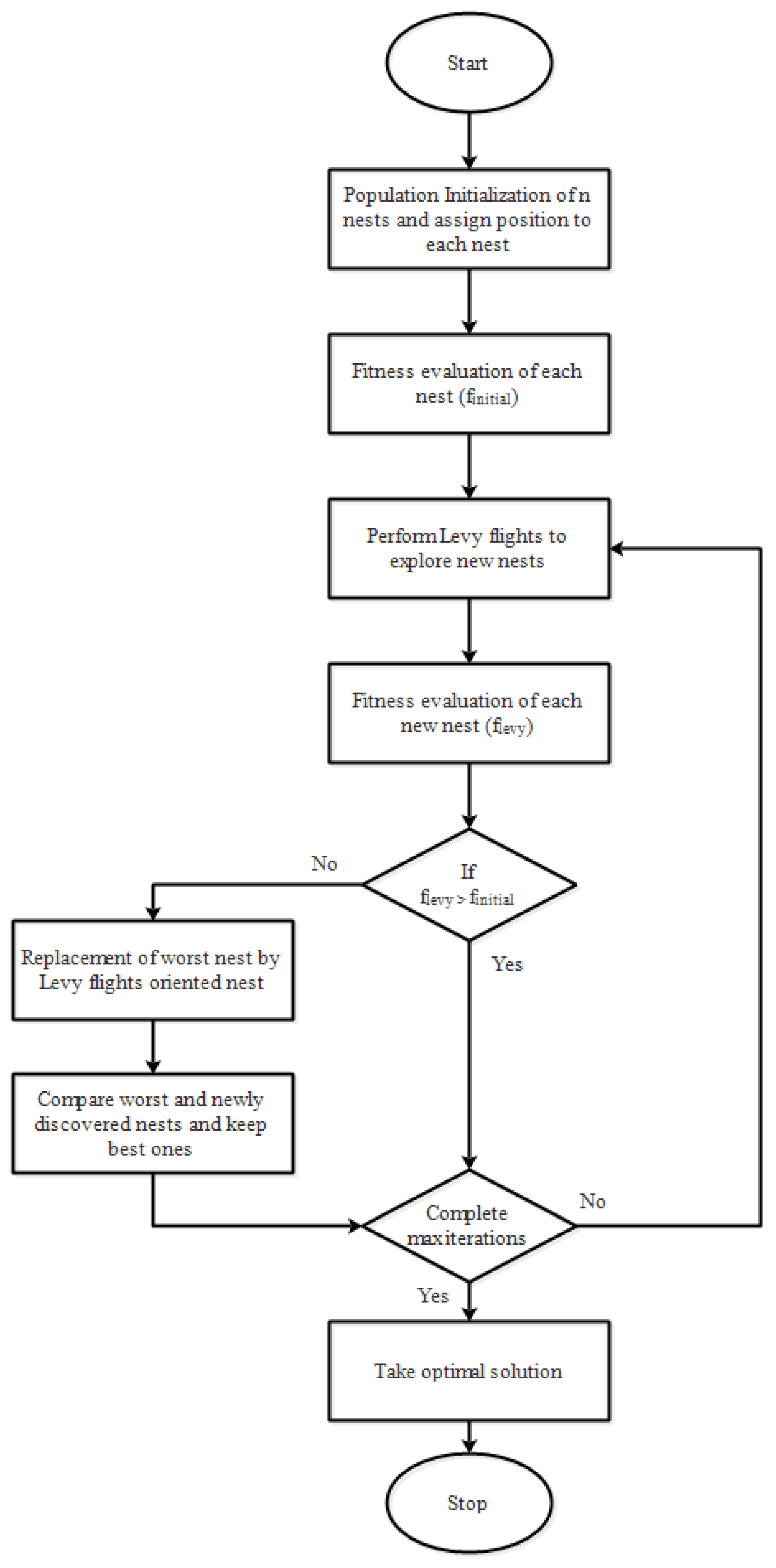

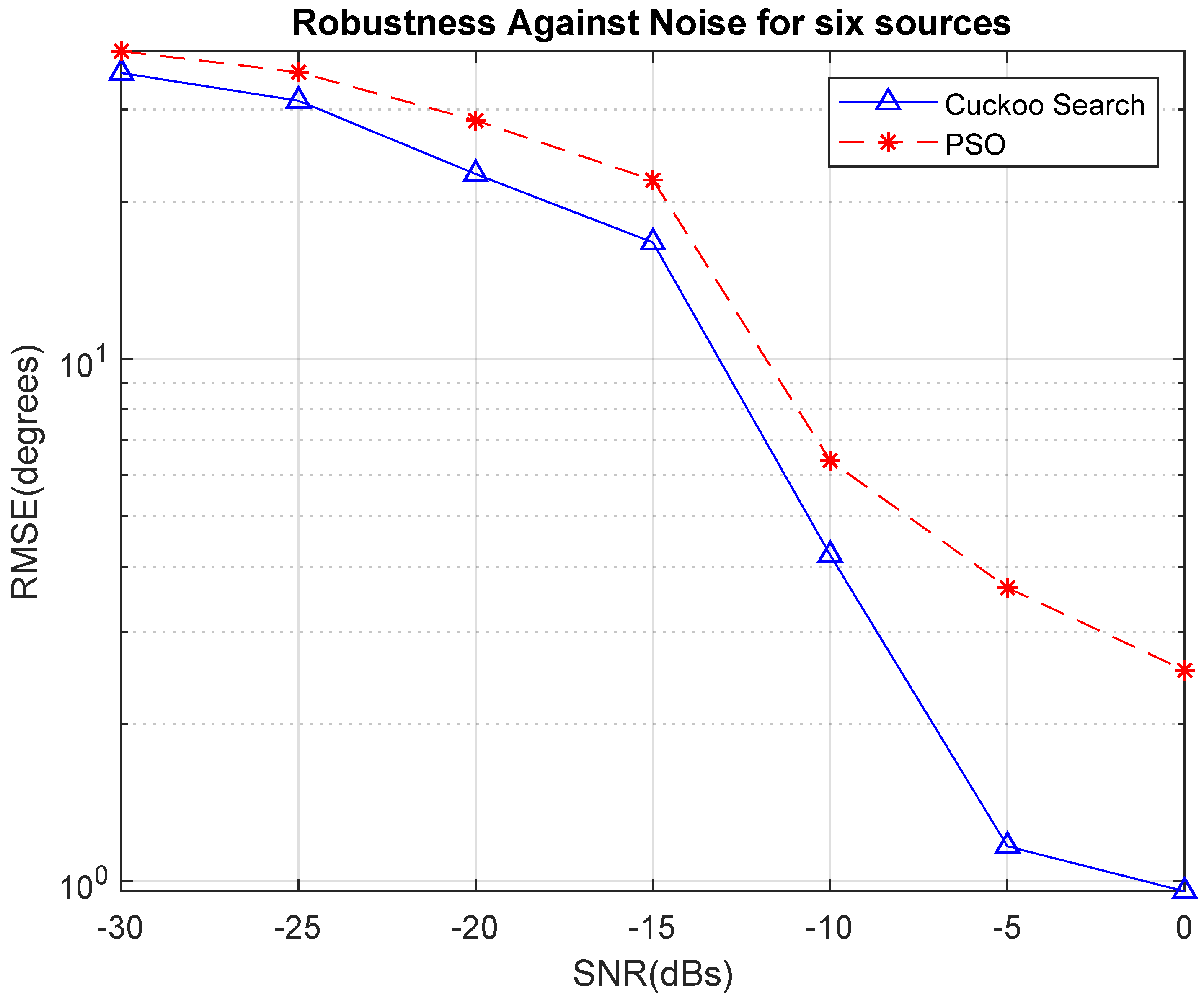


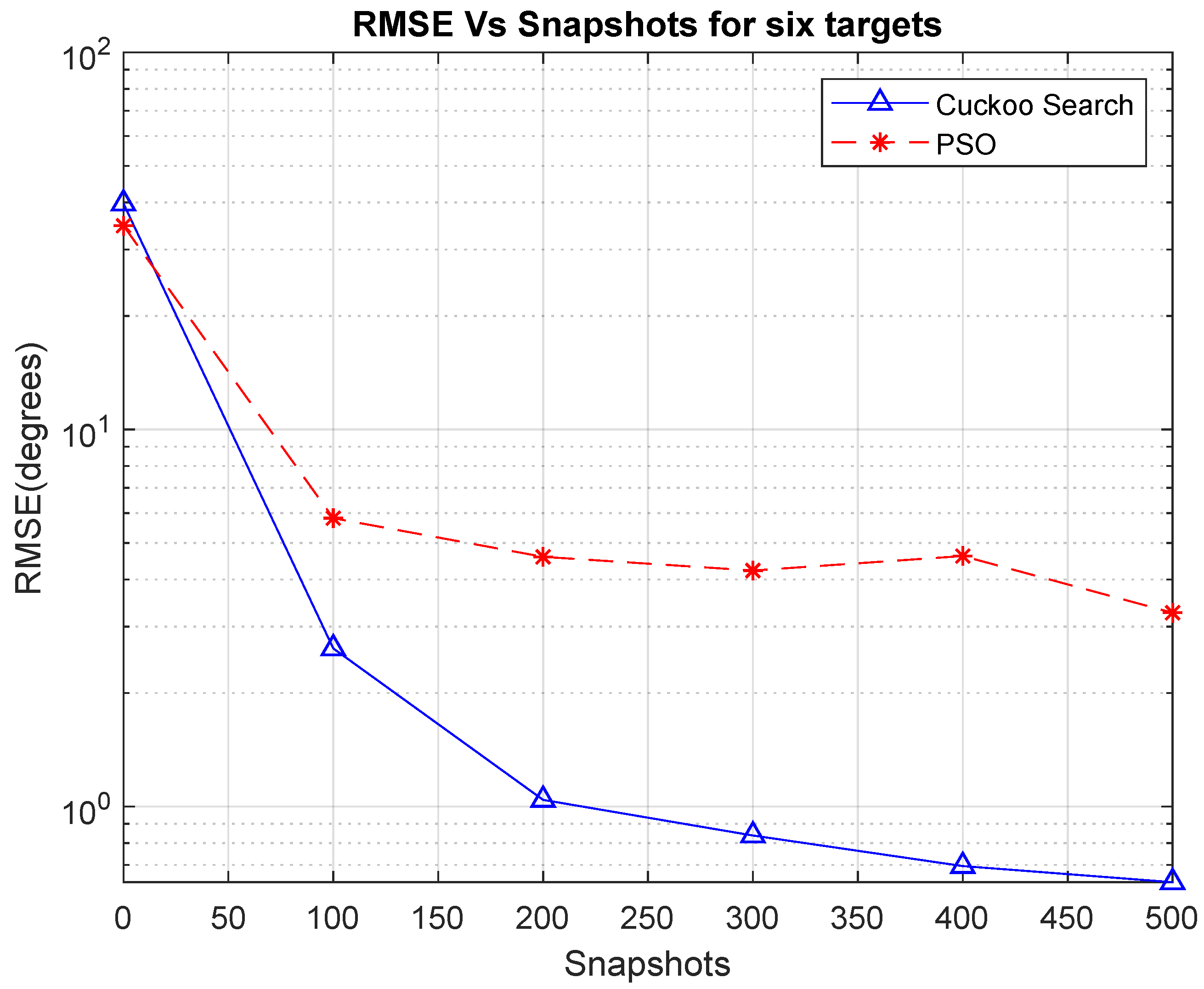
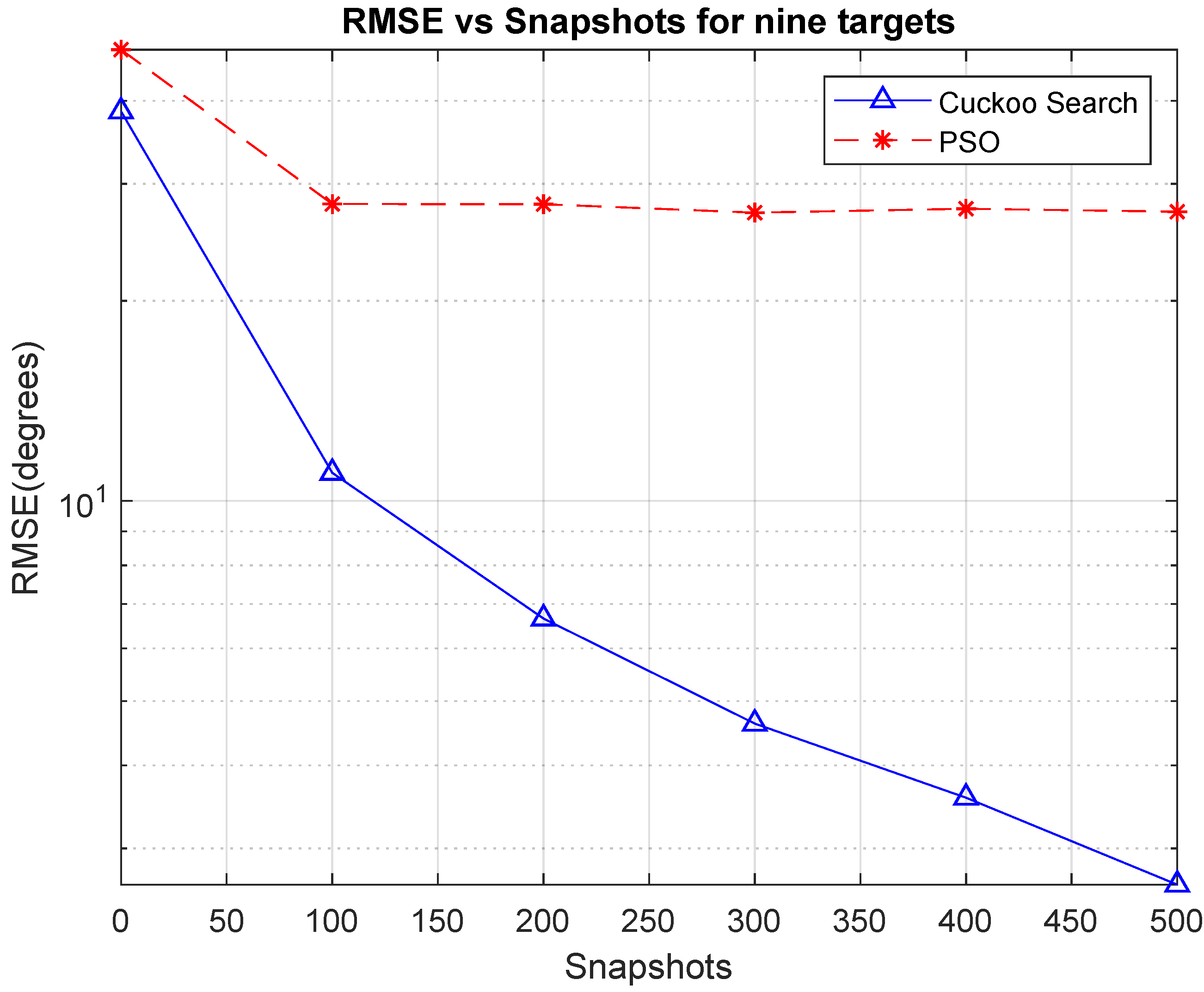


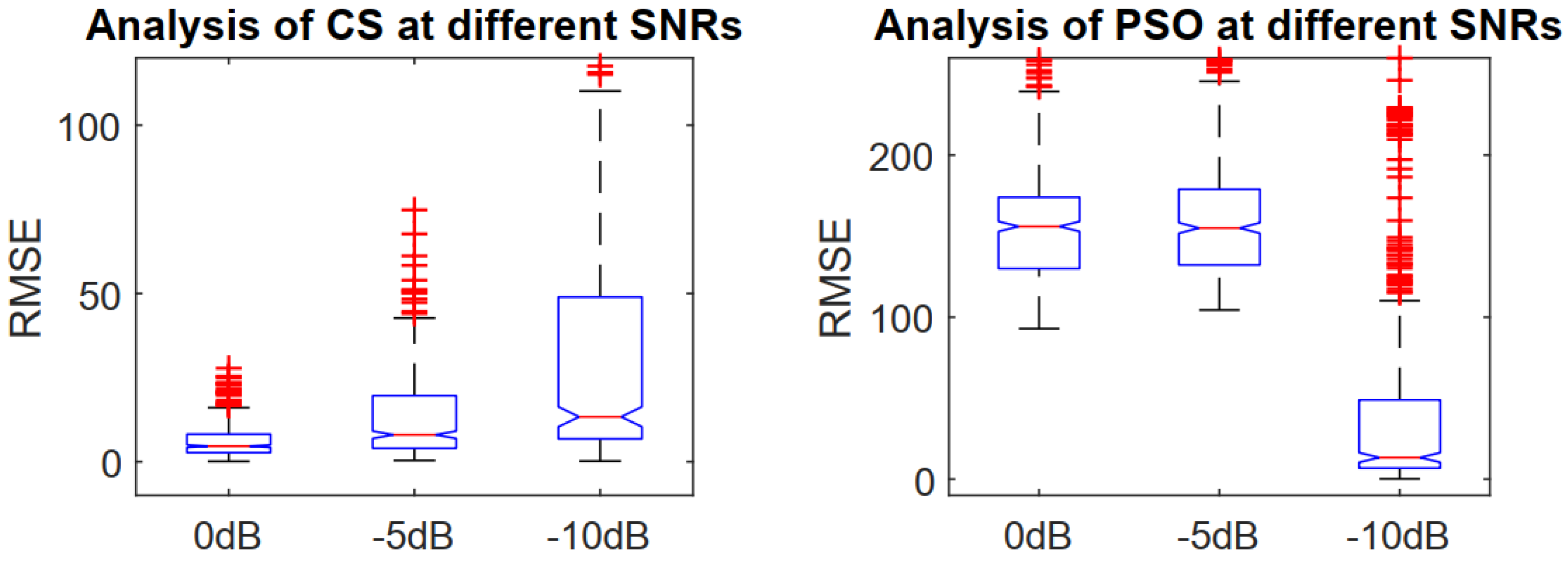
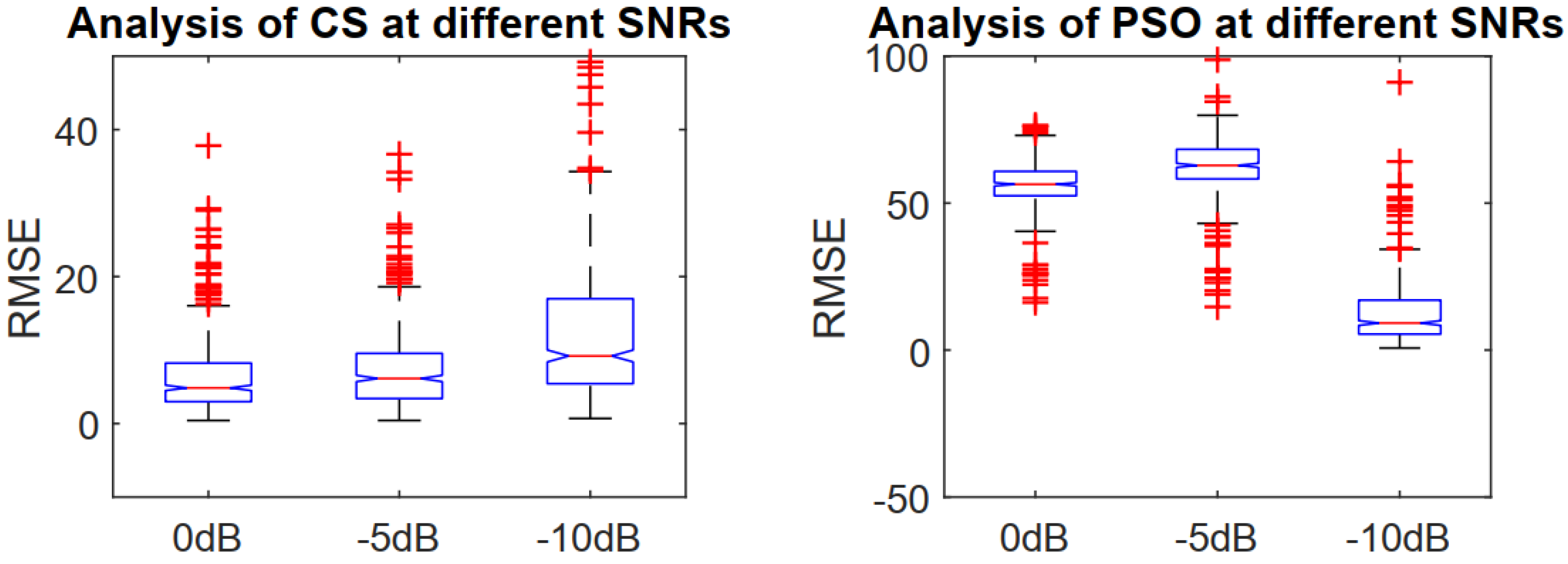
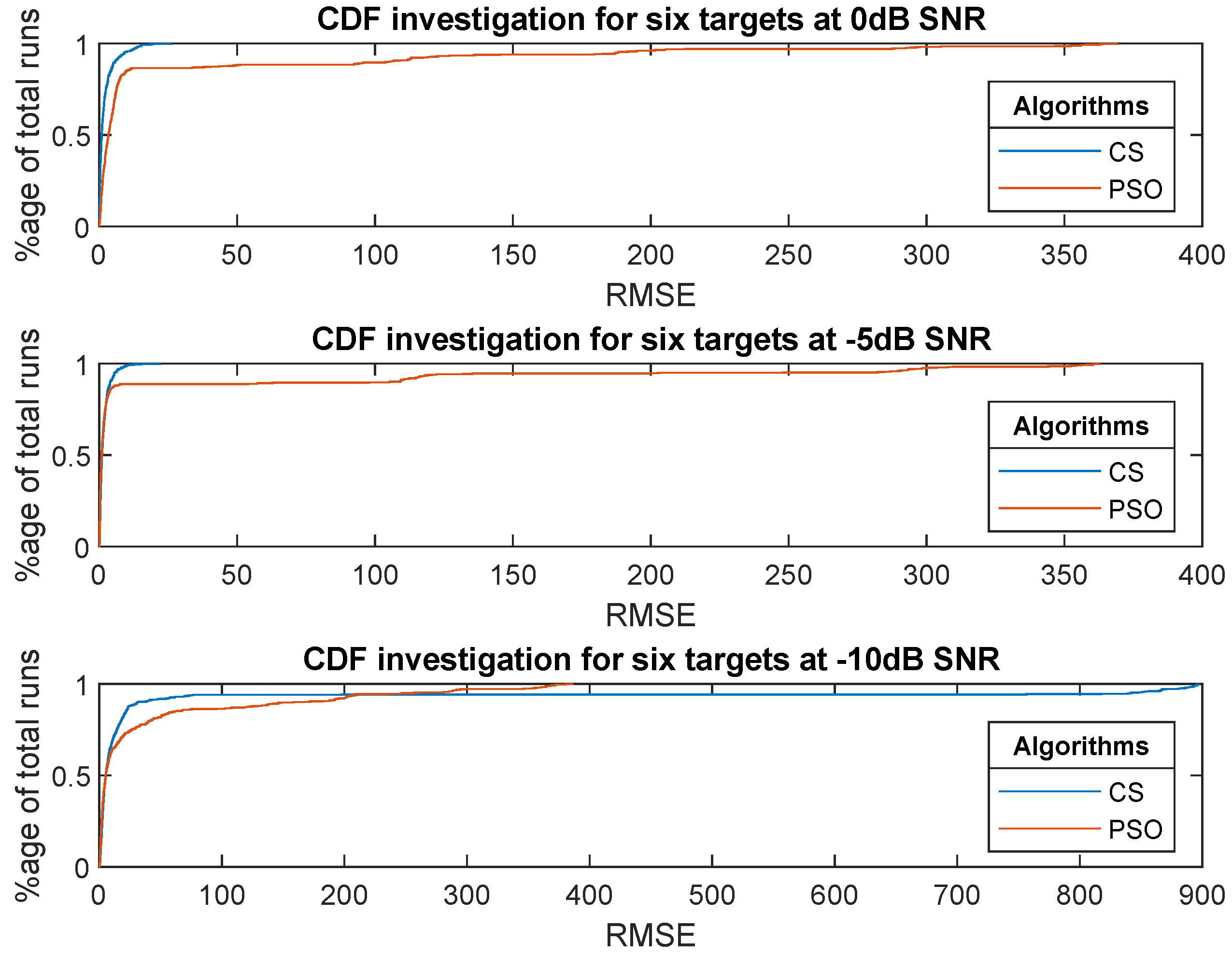
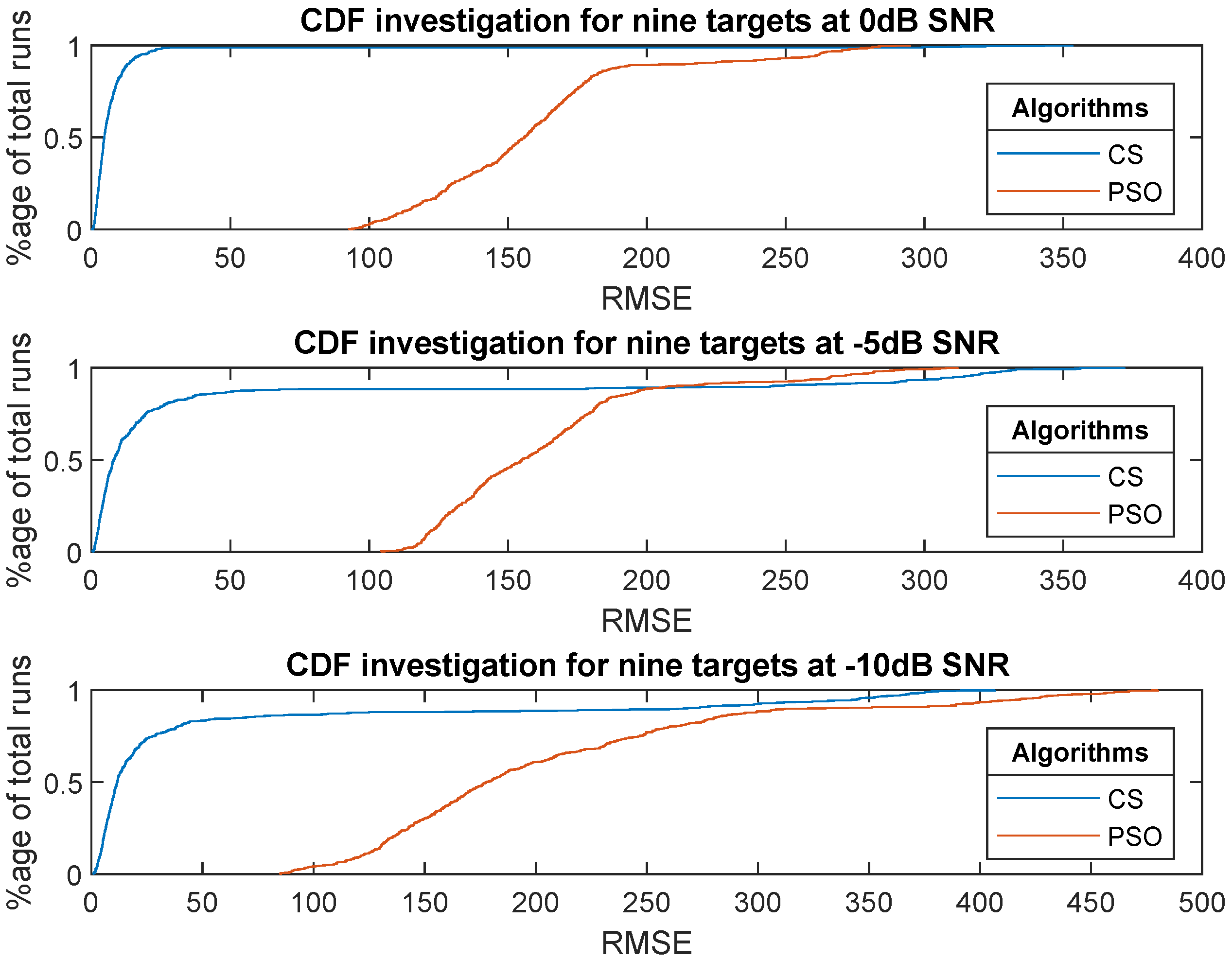
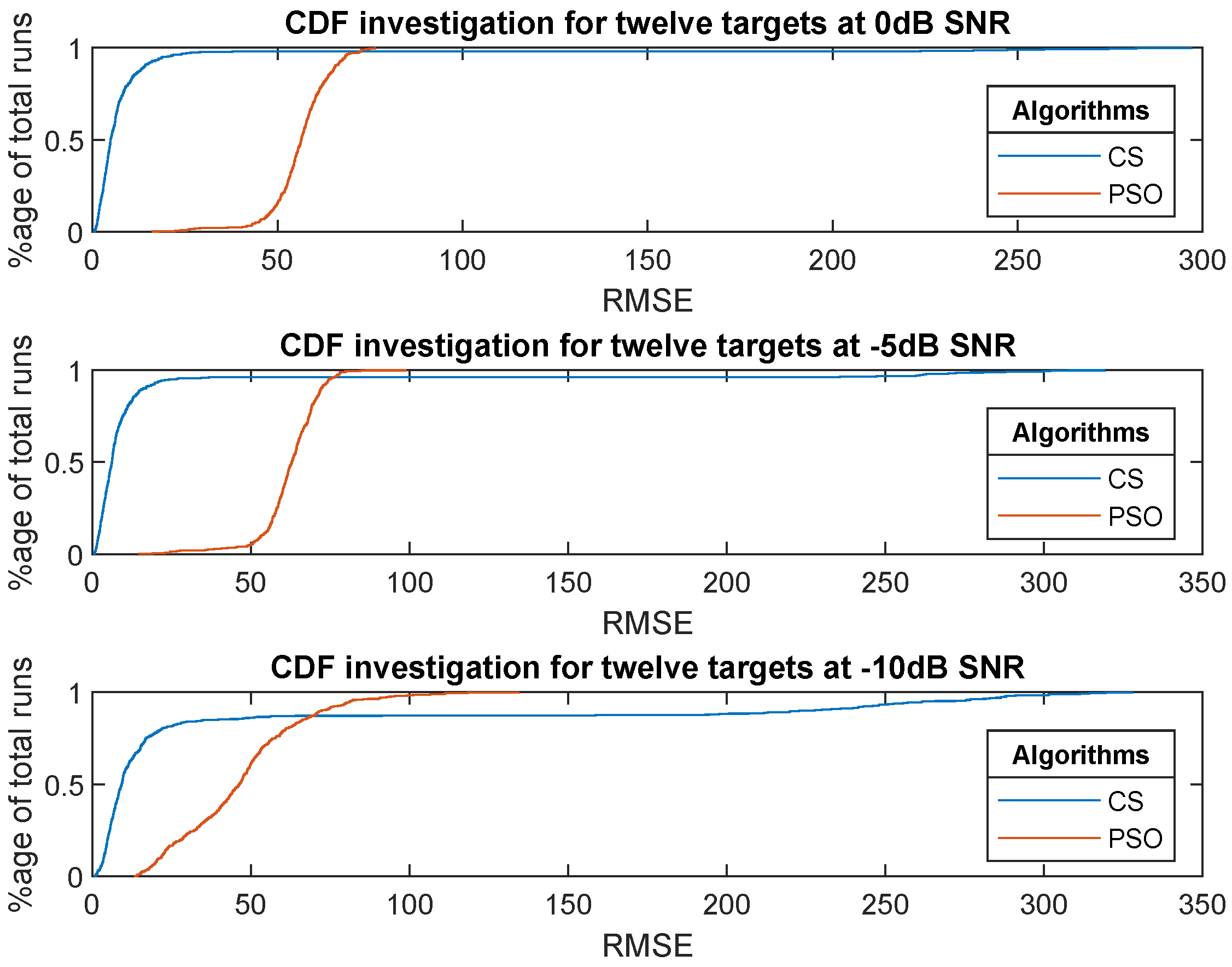



| Actual Angles (Degrees) | |||||||
|---|---|---|---|---|---|---|---|
| CS | Best | 19.957 | 40.002 | 59.826 | 79.889 | 99.897 | 120.003 |
| Mean | 18.563 | 38.750 | 59.726 | 79.373 | 101.009 | 119.917 | |
| Worst | 8.322 | 35.5332 | 58.7853 | 79.738 | 99.970 | 120.058 | |
| PSO | Best | 20.090 | 39.932 | 59.714 | 79.996 | 100.287 | 120.000 |
| Mean | 16.361 | 37.489 | 59.579 | 79.983 | 100.113 | 119.697 | |
| Worst | 0.145 | 30.027 | 39.150 | 59.312 | 79.567 | 99.001 |
| Actual Angles (Degrees) | |||||||
|---|---|---|---|---|---|---|---|
| CS | Best | 19.784 | 39.820 | 59.855 | 79.886 | 100.259 | 119.980 |
| Mean | 21.610 | 40.151 | 59.092 | 79.256 | 101.344 | 120.111 | |
| Worst | 09.287 | 36.093 | 59.598 | 78.986 | 100.932 | 119.839 | |
| PSO | Best | 19.961 | 40.075 | 59.884 | 79.839 | 99.788 | 120.000 |
| Mean | 18.405 | 38.837 | 59.709 | 79.202 | 100.519 | 119.931 | |
| Worst | 0.000 | 32.679 | 39.566 | 58.822 | 79.662 | 98.929 |
| Actual Angles (Degrees) | |||||||
|---|---|---|---|---|---|---|---|
| CS | Best | 20.470 | 40.140 | 59.923 | 79.942 | 100.017 | 120.297 |
| Mean | 15.794 | 37.302 | 61.420 | 80.681 | 99.006 | 118.444 | |
| Worst | 33.509 | 58.204 | 77.819 | 101.635 | 121.967 | 180.000 | |
| PSO | Best | 20.630 | 39.500 | 59.908 | 79.860 | 99.936 | 120.000 |
| Mean | 16.630 | 36.413 | 59.679 | 78.153 | 101.692 | 120.000 | |
| Worst | 16.630 | 36.413 | 59.679 | 78.153 | 101.692 | 120.000 |
| Actual Angles (Degrees) | ||||||||||
|---|---|---|---|---|---|---|---|---|---|---|
| CS | Best | 19.593 | 34.793 | 50.403 | 65.458 | 80.113 | 95.054 | 110.006 | 124.515 | 140.290 |
| Mean | 21.243 | 33.810 | 51.328 | 64.016 | 76.648 | 91.598 | 106.852 | 123.380 | 140.346 | |
| Worst | 29.671 | 44.863 | 62.467 | 78.987 | 95.309 | 112.152 | 127.871 | 138.777 | 180.000 | |
| PSO | Best | 21.756 | 34.090 | 50.015 | 61.225 | 74.220 | 88.506 | 100.388 | 109.193 | 120.000 |
| Mean | 21.368 | 32.547 | 48.221 | 58.335 | 68.618 | 80.331 | 93.256 | 107.042 | 120.000 | |
| Worst | 03.442 | 33.559 | 34.329 | 52.492 | 59.308 | 74.175 | 90.715 | 106.549 | 120.000 |
| Actual Angles (Degrees) | ||||||||||
|---|---|---|---|---|---|---|---|---|---|---|
| CS | Best | 19.644 | 36.090 | 50.107 | 64.055 | 79.008 | 94.836 | 110.112 | 125.026 | 140.428 |
| Mean | 19.403 | 34.089 | 48.515 | 61.256 | 76.077 | 91.722 | 105.888 | 122.097 | 138.261 | |
| Worst | 34.872 | 47.166 | 62.034 | 79.183 | 95.973 | 112.682 | 127.446 | 137.827 | 179.951 | |
| PSO | Best | 22.095 | 35.295 | 50.271 | 60.816 | 73.875 | 87.558 | 98.122 | 108.159 | 120.000 |
| Mean | 21.727 | 34.366 | 47.335 | 57.730 | 70.796 | 80.923 | 93.077 | 106.002 | 120.000 | |
| Worst | 02.153 | 32.069 | 34.862 | 50.530 | 58.640 | 74.127 | 90.846 | 105.415 | 120.000 |
| Actual Angles (Degrees) | ||||||||||
|---|---|---|---|---|---|---|---|---|---|---|
| CS | Best | 17.914 | 35.130 | 51.020 | 64.460 | 79.595 | 95.440 | 110.391 | 124.074 | 139.448 |
| Mean | 13.768 | 32.605 | 47.946 | 64.958 | 79.856 | 98.667 | 113.959 | 130.077 | 140.819 | |
| Worst | 32.106 | 47.430 | 62.859 | 79.176 | 99.025 | 115.902 | 131.446 | 137.429 | 179.741 | |
| PSO | Best | 25.352 | 34.606 | 53.414 | 65.818 | 76.683 | 91.433 | 103.044 | 109.174 | 120.000 |
| Mean | 24.897 | 31.474 | 46.282 | 57.235 | 69.460 | 77.796 | 91.801 | 106.276 | 120.000 | |
| Worst | 01.602 | 32.134 | 35.065 | 49.745 | 60.489 | 69.987 | 80.391 | 96.584 | 111.233 |
| Actual Angles (Degrees) | |||||||||||||
|---|---|---|---|---|---|---|---|---|---|---|---|---|---|
| CS | Best | 20.771 | 29.991 | 40.635 | 49.744 | 60.279 | 69.337 | 79.937 | 89.905 | 100.259 | 108.893 | 119.588 | 131.413 |
| Mean | 15.644 | 33.214 | 36.495 | 49.199 | 58.992 | 68.778 | 78.185 | 88.490 | 99.042 | 107.952 | 118.438 | 130.534 | |
| Worst | 32.892 | 34.780 | 49.417 | 59.459 | 71.079 | 80.331 | 89.889 | 99.921 | 109.528 | 118.439 | 130.460 | 179.997 | |
| PSO | Best | 25.423 | 25.724 | 43.204 | 51.689 | 63.631 | 71.924 | 82.989 | 90.470 | 100.336 | 107.281 | 120.000 | 120.000 |
| Mean | 23.636 | 23.944 | 37.693 | 47.767 | 54.461 | 64.581 | 72.960 | 82.334 | 90.031 | 99.924 | 107.863 | 120.000 | |
| Worst | 21.932 | 30.708 | 31.234 | 49.225 | 49.640 | 63.914 | 70.749 | 80.705 | 88.585 | 98.879 | 107.166 | 120.000 |
| Actual Angles (Degrees) | |||||||||||||
|---|---|---|---|---|---|---|---|---|---|---|---|---|---|
| CS | Best | 20.609 | 30.658 | 40.470 | 49.065 | 58.658 | 69.505 | 79.987 | 90.209 | 99.895 | 108.988 | 120.244 | 130.064 |
| Mean | 16.200 | 33.655 | 35.757 | 49.880 | 59.819 | 71.005 | 79.543 | 88.954 | 96.921 | 106.396 | 118.447 | 129.422 | |
| Worst | 33.631 | 36.751 | 51.618 | 60.733 | 71.977 | 80.107 | 91.166 | 100.355 | 110.272 | 121.987 | 130.929 | 180.000 | |
| PSO | Best | 24.594 | 26.424 | 40.313 | 49.013 | 56.839 | 68.693 | 76.945 | 88.490 | 101.784 | 106.160 | 120.000 | 120.000 |
| Mean | 19.786 | 30.707 | 37.353 | 51.786 | 52.633 | 66.785 | 72.0238 | 83.242 | 88.560 | 98.188 | 105.903 | 120.000 | |
| Worst | 18.306 | 29.093 | 29.594 | 46.470 | 49.143 | 61.943 | 69.262 | 78.375 | 87.403 | 96.631 | 106.210 | 120.000 |
| Actual Angles (Degrees) | |||||||||||||
|---|---|---|---|---|---|---|---|---|---|---|---|---|---|
| CS | Best | 19.231 | 30.410 | 39.738 | 50.089 | 59.972 | 68.568 | 78.721 | 89.754 | 101.099 | 110.242 | 118.923 | 128.847 |
| Mean | 13.739 | 32.169 | 36.198 | 46.861 | 59.284 | 69.950 | 80.950 | 93.324 | 103.538 | 113.336 | 121.217 | 132.087 | |
| Worst | 32.608 | 34.556 | 46.973 | 59.788 | 64.350 | 78.185 | 95.780 | 106.395 | 114.413 | 122.340 | 132.117 | 180.000 | |
| PSO | Best | 25.788 | 26.402 | 41.916 | 51.693 | 60.857 | 68.785 | 79.025 | 90.077 | 101.744 | 108.859 | 119.960 | 120.000 |
| Mean | 20.911 | 30.796 | 36.900 | 49.856 | 56.640 | 71.017 | 71.499 | 84.186 | 91.056 | 101.661 | 106.794 | 120.000 | |
| Worst | 5.759 | 28.905 | 29.014 | 42.225 | 47.788 | 59.724 | 65.001 | 76.072 | 87.495 | 97.088 | 108.557 | 120.000 |
Publisher’s Note: MDPI stays neutral with regard to jurisdictional claims in published maps and institutional affiliations. |
© 2022 by the authors. Licensee MDPI, Basel, Switzerland. This article is an open access article distributed under the terms and conditions of the Creative Commons Attribution (CC BY) license (https://creativecommons.org/licenses/by/4.0/).
Share and Cite
Hameed, K.; Khan, W.; Abdalla, Y.S.; Al-Harbi, F.F.; Armghan, A.; Asif, M.; Salman Qamar, M.; Ali, F.; Miah, M.S.; Alibakhshikenari, M.; et al. Far-Field DOA Estimation of Uncorrelated RADAR Signals through Coprime Arrays in Low SNR Regime by Implementing Cuckoo Search Algorithm. Electronics 2022, 11, 558. https://doi.org/10.3390/electronics11040558
Hameed K, Khan W, Abdalla YS, Al-Harbi FF, Armghan A, Asif M, Salman Qamar M, Ali F, Miah MS, Alibakhshikenari M, et al. Far-Field DOA Estimation of Uncorrelated RADAR Signals through Coprime Arrays in Low SNR Regime by Implementing Cuckoo Search Algorithm. Electronics. 2022; 11(4):558. https://doi.org/10.3390/electronics11040558
Chicago/Turabian StyleHameed, Khurram, Wasim Khan, Yasser S. Abdalla, Fatemah F. Al-Harbi, Ammar Armghan, Muhammad Asif, Muhammad Salman Qamar, Farman Ali, Md Sipon Miah, Mohammad Alibakhshikenari, and et al. 2022. "Far-Field DOA Estimation of Uncorrelated RADAR Signals through Coprime Arrays in Low SNR Regime by Implementing Cuckoo Search Algorithm" Electronics 11, no. 4: 558. https://doi.org/10.3390/electronics11040558
APA StyleHameed, K., Khan, W., Abdalla, Y. S., Al-Harbi, F. F., Armghan, A., Asif, M., Salman Qamar, M., Ali, F., Miah, M. S., Alibakhshikenari, M., & Dalarsson, M. (2022). Far-Field DOA Estimation of Uncorrelated RADAR Signals through Coprime Arrays in Low SNR Regime by Implementing Cuckoo Search Algorithm. Electronics, 11(4), 558. https://doi.org/10.3390/electronics11040558








